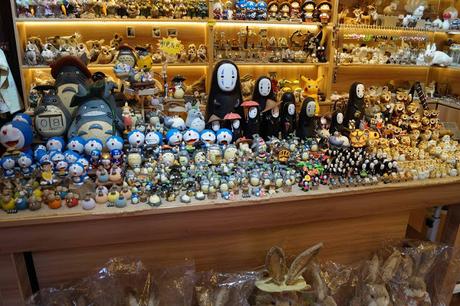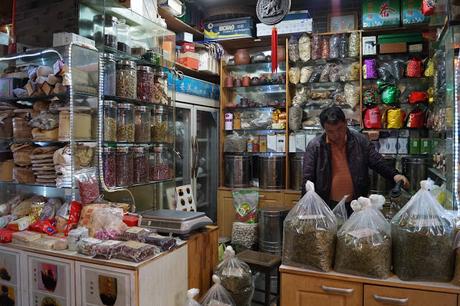La semana pasada empecé a contaros mi viaje a Shanghai, pero aún me quedaban cosas por enseñaros. Uno de los lugares que más nos gustó fue Xintiandi, un agradable barrio formado por casas antiguas “Shikumen” que fueron restauradas para albergar tiendas, restaurantes y cafés. Un buen sitio donde comprar artesanía. Además disfruté como una niña en las tiendas de productos manga y anime.
Last week I started telling you about my trip to Shanghai, but still had somethings to show you. One of the sites that we liked most was Xintiandi, a nice neighborhood formed by ancient houses "Shikumen" that were restored to host shops, restaurants and coffees. A good place where buying crafts. Besides I enjoyed as a child in the shops of manga and anime stuff.




Y encontramos un pequeño mercado con productos bastante exóticos.
And we find a small market with quite exotic products.




Tianzifang, el barrio de la antigua Concesión Francesa, prometía ser igual de encantador pero nos pareció un poco de "cartón piedra" y se ha convertido en un lujoso centro comercial. Aún así mereció la pena visitar allí la casa en la que se celebró el Primer Congreso Nacional del Partido Comunista Chino. Hoy en día es un museo en el que se puede ver la habitación en la que Mao Zedong y los delegados procedentes de toda China se reunieron en 1921 para fundar el Partido Comunista. ¿No os parece esta antigua bandera que se expone en el museo un trabajo de patchwork?
Tianzifang, the neighborhood of the old French Concession, promised to also a charming place but we found it a cardboard disctict and it has turned into a luxurious mall. But it was worth visiting there the house where the First National Congress of the Chinese Communist party was celebrated. Nowadays it is a museum where it is possible to see the room in which Mao Zedong and the delegates from the whole China met in 1921 and founded the Communist party. Don’t you think this old flag exhibited in the museum is in fact a quilt?

A unos 180 km. de Shanghai se halla Hangzhou, la capital de la provincia de Zhejiang y una de las siete antiguas capitales de China. Llena de jardines e importantes edificaciones históricas y con un bonito lago entorno al cual creció la ciudad, bien vale una escapada. De camino en autobús paramos en un área de servicio donde podías comprar "deliciosos" tentempiés de pato o ranas rebozadas.
Hangzhou, the capital of Zhejiang's province and one of seven former capitals of China, is located approximately 180 km from Shanghai. It is full of gardens, historical buildings and with a nice lake around which the city grew. On our bus ride we stopped at a service area where you could buy "delicious" duck or coated frogs snacks.


El Lago del Oeste está en el centro de Hangzhou, rodeado de templos, pabellones, pagodas y jardines. Visitamos uno de los templos y nos relajamos con un agradable paseo en barca.
The West Lake is in Hangzhou's center, surrounded by pavilions, pagodas and gardens. We visited one of the temples and relax with a nice boat trip.



Después fuimos al Templo Lingyin, situado en un estrecho valle, entre colinas y bosques. En el camino te vas encontrando con algunas de las 470 estatuas de Buda esculpidas en la roca a lo largo del bosque.
Later we went to Lingyin Temple, placed in a narrow valley, between hills and forests. In the way you find some of the 470 Buddha statues carved into the rock along the forest.

Es un templo muy grande, con numerosos edificios y salas. La principal es la sala del Gran Héroe, que contiene una magnífica estatua de 20 metros de Sakyamuni, el Buda sentado sobre una flor de loto.
It is a very big temple, with plenty of buildings and halls. The main one is the Hall of the Great Hero, which contains a 20-meters magnificent statue of Sakyamuni, the Buddha sitting on a lotus flower.




Pero la más llamativa es la Sala de los quinientos Arhats (las almas de quienes han alcanzado el nirvana y no volverán a reencarnarse). Tiene forma de cruz gamada en cuyos brazos se disponen 500 estatuas de bronce todas diferentes, un poco raras y hasta divertidas.
But the most striking one is the Hall of the 500 Arhats (the souls of those who have reached the Nirvana and will not reincarnate again). It is shaped like a swastika in whose arms 500 statues are placed. They are made of bronze and all are different, a little weird and even funny.

Como veis, ha sido un viaje corto pero muy intenso.
As you see, it has been a short but very intense trip.


